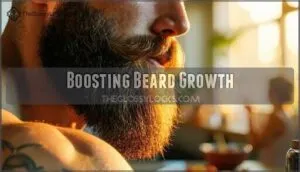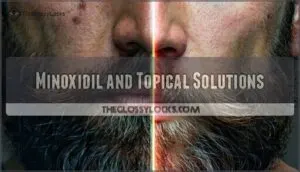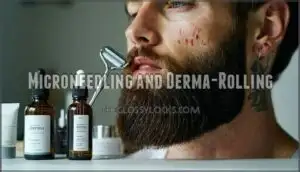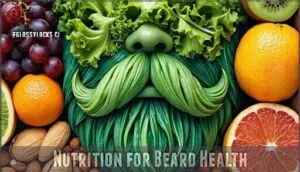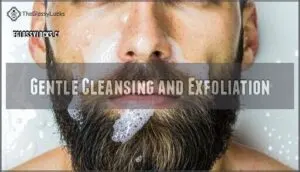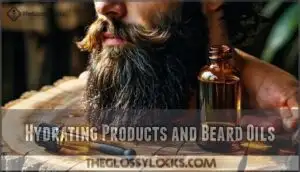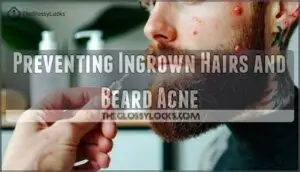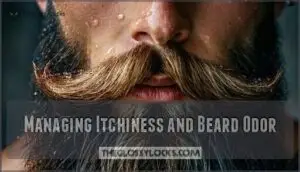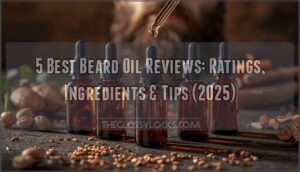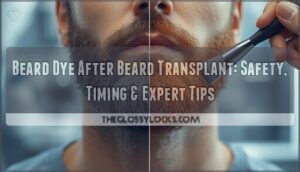This site is supported by our readers. We may earn a commission, at no cost to you, if you purchase through links.
 For healthy, thicker beards, focus on proper care and a balanced lifestyle.
For healthy, thicker beards, focus on proper care and a balanced lifestyle.
Hydrate your skin and hair with oils like argan or jojoba, which keep dryness and itchiness at bay. Eat nutrient-rich foods packed with biotin, zinc, and protein to fuel growth from the inside out.
Stay active, as regular exercise boosts testosterone, a major player in beard growth. Cleanse and exfoliate gently to prevent clogged pores or ingrown hairs.
If genetics aren’t pulling their weight, consider options like minoxidil or microneedling to stimulate hair follicles. With patience and the right habits, you’ll have a beard that turns heads in no time.
Table Of Contents
- Key Takeaways
- Causes of Thinning Beard
- Boosting Beard Growth
- Non-Surgical Enhancement Methods
- Nutrition for Beard Health
- Beard Care and Maintenance
- Frequently Asked Questions (FAQs)
- How to grow a beard naturally?
- What is the best hair growth product for a beard?
- How can I increase my facial beard growth?
- Can supplementation help prevent uniform beard growth?
- How do you treat a patchy beard?
- What helps beard growth and thickness?
- How do I stop my beard from being thick?
- What are the remedies for thicker beard?
- What are the best tools for beard grooming?
- How often should a beard be trimmed?
- Conclusion
Key Takeaways
- Eat a nutrient-rich diet with biotin, zinc, protein, and omega-3s to fuel beard growth from the inside out.
- Use beard oils like argan or jojoba to hydrate and prevent dryness and itchiness for healthier facial hair.
- Manage stress and stay active to boost testosterone levels, which are key for thicker beard growth.
- Consider proven methods like microneedling or minoxidil to stimulate follicles and improve beard density if needed.
Causes of Thinning Beard
Your beard’s thickness depends on several interconnected factors that you can understand and address.
Understanding the key factors behind beard thickness unlocks your path to achieving a stronger, fuller, and healthier beard growth.
Genetics, hormonal changes, stress levels, poor nutrition, and aging all contribute to thinning facial hair.
Identifying these causes helps you choose the right treatment approach, but it is crucial to understand that addressing the root cause is key to improving your beard’s thickness.
Genetics and Hormonal Imbalance
Your genetic blueprint determines beard thickness more than any cream or supplement ever could.
If your father sports a patchy beard, you’re likely fighting an uphill battle against DHT sensitivity and inherited growth patterns.
Key genetic and hormonal factors affecting your beard:
- Genetic predisposition controls hair follicle density and distribution across your face
- Hormonal imbalances reduce testosterone levels, directly impacting beard thickness and growth rate
- DHT sensitivity varies between individuals, determining how follicles respond to growth signals
Poor Diet and Nutrition
What you eat directly impacts your beard’s thickness and health.
Dietary deficiencies in zinc, biotin, and iron leave follicles starved for essential nutrients. Processed foods create inflammation that weakens growth, while poor hydration limits nutrient transport to hair roots.
| Growth Killers | Beard Boosters |
|---|---|
| Processed junk food | Nutrient-rich whole foods |
| Sugar-heavy snacks | Protein-packed meals |
| Dehydration habits | Adequate water intake |
Stress and Lifestyle Choices
Everyone knows stress wreaks havoc on your beard growth, but few realize how deeply lifestyle choices impact facial hair thickness.
Chronic stress elevates cortisol levels, disrupting testosterone production and weakening hair follicles. Your daily habits either fuel or starve your beard’s potential.
Elevate your daily habits—reduce stress, boost testosterone, and unleash your beard’s full potential with simple, consistent lifestyle changes.
- Stress management through meditation reduces cortisol and promotes healthy hormone balance
- Sleep quality affects growth hormones that repair and strengthen beard follicles
- Smoking effects restrict blood flow, depriving follicles of essential nutrients
Aging and Medical Conditions
As you age, hormonal changes naturally reduce testosterone levels, leading to age-related thinning and weaker follicles.
Medical conditions like alopecia areata cause patchy beard hair loss, while autoimmune impacts disrupt normal growth cycles.
Chronic illness effects and medication side effects compound these issues, making consultation with a beard dermatologist essential for proper diagnosis.
| Condition Type | Impact on Beard |
|---|---|
| Hormonal Changes | Reduced testosterone, weaker follicles |
| Autoimmune Disorders | Patchy beard alopecia, irregular growth |
| Chronic Medications | Medical hair loss, thinning patterns |
Boosting Beard Growth
When you’ve identified the factors causing beard thinning, you can target specific strategies to enhance your facial hair growth and thickness.
Your body’s natural beard-growing ability responds well to hormonal optimization, proper nutrition, regular exercise, and stress management techniques that work together to create ideal conditions for stronger, fuller facial hair, utilizing hormonal optimization.
Role of Testosterone and Magnesium
When testosterone levels drop, your beard density takes a hit.
Magnesium benefits include supporting hormone balance and follicle stimulation naturally.
Here’s how to boost your beard thickness:
- Eat spinach daily – magnesium powerhouse for testosterone
- Add ginger to meals – natural hormone booster
- Include garlic regularly – supports healthy beard hormone levels
- Try magnesium supplements – maintains ideal hormonal changes for growth
Importance of Vitamin D and Zinc
Your body needs specific vitamins and minerals to build thick, healthy facial hair.
Vitamin D benefits include activating hair follicles, while zinc deficiency signs show up as patchy growth.
You’ll find D/Zinc food sources in tuna, salmon, and eggs.
Supplement effectiveness improves when you maintain ideal intake levels, and these beard vitamins growth essentials transform weak whiskers into robust, thick facial hair through proper mineral support.
Exercise and Healthy Weight Management
Regular physical activity delivers Exercise Benefits that directly impact your facial hair’s destiny.
Weightlifting and cardiovascular exercises create a Circulation Boost that feeds hungry follicles while naturally elevating Testosterone Levels.
Maintaining healthy weight through consistent exercise becomes one of the most effective beard thickness solutions. Your Weights Impact extends beyond muscle—each workout session strengthens the foundation for robust beard growth.
Stress Reduction Techniques
Your stress levels directly impact your beard’s potential through hormonal disruption.
Chronic stress elevates cortisol, which suppresses testosterone production and weakens hair follicles, leading to patchy growth and reduced beard thickness.
Here are four proven stress reduction techniques for maximal beard health:
- Mindfulness Meditation – Practice 10-15 minutes daily to lower cortisol levels
- Yoga Benefits – Combines physical movement with stress relief
- Deep Breathing – Activates parasympathetic nervous system instantly
- Sleep Quality – Guarantees proper hormone regulation and recovery
Non-Surgical Enhancement Methods
You can enhance your beard’s thickness and density through proven non-surgical treatments that stimulate follicles and improve circulation.
These evidence-based methods, including topical solutions, laser therapy, microneedling, and targeted nutrition, offer effective alternatives to surgical procedures with consistent results over time, and they can be considered as non-surgical treatments.
Minoxidil and Topical Solutions
You’ve built the foundation with lifestyle changes, now let’s explore proven topical treatments. Minoxidil stands as the gold standard for beard thickness enhancement. This FDA-approved solution boosts blood flow to follicles, delivering nutrients that promote growth.
While minoxidil efficacy varies between individuals, studies show impressive results within 3-12 months of consistent use. Many users find success with minoxidil beard products.
| Treatment Type | Application Method | Expected Timeline |
|---|---|---|
| 5% Minoxidil Foam | Twice daily to clean skin | 3-6 months for visible results |
| 2% Minoxidil Liquid | Once daily with gentle massage | 6-12 months for full effects |
| Beard Thickness Serum | Morning and evening routine | 2-4 months for density improvement |
| Topical DHT Blockers | Apply after cleansing | 4-8 months for follicle protection |
Solution absorption depends on proper application technique. Clean your face thoroughly, apply the recommended amount, and allow complete drying before touching. Potential side-effects include mild skin irritation and dryness, though most men tolerate topical treatments well.
Long-term usage maintains results – stopping treatment typically reverses gains within months. Beard DHT blockers complement minoxidil by preventing follicle miniaturization, creating a thorough approach to beard thickness enhancement.
Low-Level Laser Therapy (LLLT)
LLLT’s mechanism harnesses red light wavelengths to boost cellular energy in your beard follicles.
This FDA-approved light therapy enhances beard growth stimulation by increasing ATP production and extending hair growth phases.
LLLT devices range from professional clinic treatments to at-home helmets, with proven LLLLT effectiveness for beard thickness.
Discover products for beard growth that utilize this technology.
LLLT safety profiles show minimal side effects, though LLLLT cost varies substantially.
Microneedling and Derma-Rolling
Microneedling and dermarolling create controlled micro-injuries that trigger collagen stimulation in your beard area.
Choose proper needle length (0.5-1.5mm) since technique matters for ideal beard thickness and density. These tools boost beard follicle stimulation by increasing blood flow and nutrient absorption.
Many users explore options for microneedling beard products to support their growth journey. However, scarring risks exist with improper use, making post-treatment care with quality serums essential for safe, effective results, and to achieve beard growth.
Nutrient-Rich Diet and Supplements
While microneedling creates pathways for nutrients, your beard’s foundation depends on what you feed it.
A nutrientrich diet packed with beard vitamins growth transforms patchy areas into fuller coverage through consistent nourishment.
Your beard density increase relies on these key nutrients:
- Biotin Benefits – Strengthens follicles through eggs and nuts
- Omega-3 Power – Nourishes roots via fish and seeds
- Vitamin Importance – Boosts collagen with citrus fruits
- Protein Sources – Builds stronger hair from lean meats
Nutrition for Beard Health
Your beard’s health and thickness depend largely on the nutrients you provide your body through your daily diet.
Essential vitamins like biotin, omega-3 fatty acids, and protein work together to strengthen hair follicles, promote growth, and create the dense, healthy beard you’re seeking.
Biotin and Vitamin-Rich Foods
Boosting beard health starts with biotin food sources.
Eggs, nuts, and seeds strengthen follicles, while a nutrient-rich diet supports beard thickness.
Vitamins like A, C, D, and E improve absorption rates and enhance follicle growth.
Adding beard vitamins for growth guarantees your facial hair thrives.
A healthy diet isn’t just fuel; it’s your beard’s secret weapon.
Omega-3 Fatty Acids and Protein Sources
Omega-3 fatty acids and protein are key to beard thickness and health.
Omega-3 benefits include follicle nourishment and reduced inflammation.
Protein supports beard structure through efficient protein synthesis, and incorporating dietary sources like salmon, walnuts, eggs, and lentils into your meals can be beneficial.
A healthy diet strengthens follicles, helping your beard grow fuller and more robust, emphasizing overall beard health.
Natural Remedies Like Onion Juice and Castor Oil
For a thicker beard naturally, onion juice benefits shine by strengthening follicles with sulfur and boosting growth.
Castor oil uses include nourishing roots and locking in moisture.
Combine them into DIY beard masks for natural beard growth. Massage this blend in, let it sit, and rinse.
Pair with amla oil application for even better results!
Essential Oils for Beard Growth
While remedies like onion juice boost growth, essential oils offer a gentler, aromatic path to a thicker beard naturally.
Blends featuring rosemary, cedarwood, or peppermint deliver beard oil benefits by improving circulation and nourishing follicles.
Use carrier oils like jojoba for safe application, and always verify quality sourcing.
These beard growth tips promote natural beard growth with every drop.
Beard Care and Maintenance
Proper beard care keeps your facial hair healthy, thick, and free of common issues like dryness or irritation.
By cleansing gently, hydrating regularly, and addressing problems like ingrown hairs or beard odor, you can maintain a beard that’s both strong and well-groomed.
Gentle Cleansing and Exfoliation
Keep your beard healthy and thick by focusing on gentle cleansing and exfoliation.
Use a mild beard shampoo to remove dirt without stripping natural oils. Exfoliation frequency matters—once or twice weekly clears dead skin and prevents clogged pores.
Good hygiene isn’t optional; it’s the backbone of proper beard care.
Combine this with trimming techniques to maintain a polished look.
Hydrating Products and Beard Oils
Healthy beard care isn’t just about washing; hydration matters too.
Using beard oils guarantees proper beard hydration, reducing dryness and itchiness.
Choose products with natural carrier oils like jojoba or argan, which nourish and lock in moisture.
Pay attention to product ingredients and scent profiles for a personalized experience.
Regular oil application keeps your beard soft, manageable, and promotes overall beard health.
Preventing Ingrown Hairs and Beard Acne
Exfoliation techniques can prevent ingrown hairs by keeping beard pores clear.
Use gentle circular motions to remove dead skin, reducing beard bumps.
Proper shaving matters—shave along the grain to avoid irritations.
For beard acne, pore cleansing is essential; look for product ingredients like salicylic acid.
Aftershave solutions with soothing properties also help maintain beard hygiene and reduce inflammation.
Managing Itchiness and Beard Odor
Tackling beard itch and odor isn’t tough with the right routine.
Focus on solid hygiene practices and thoughtful product selection to keep your beard fresh and itch-free.
- Use beard tea tree oil for itch relief and odor control.
- Wash daily with gentle, sulfate-free beard cleansers.
- Try home remedies like aloe vera to soothe irritation and boost beard hygiene.
Frequently Asked Questions (FAQs)
How to grow a beard naturally?
To grow a beard naturally, focus on a nutrient-rich diet with proteins, biotin, and vitamins like D and E.
Stay hydrated, manage stress, exercise regularly, and massage your face gently to boost blood flow and follicle health, which can help with follicle health.
What is the best hair growth product for a beard?
Picture your beard as a garden—it thrives with care.
Minoxidil is a top pick, scientifically proven to boost beard growth.
Combine it with biotin supplements, derma-rolling, and a proper grooming routine for noticeable results.
How can I increase my facial beard growth?
To boost facial beard growth, focus on a nutrient-rich diet, exercise regularly, and reduce stress.
Massage your face with oils like castor or coconut, and consider biotin supplements or non-surgical treatments like microneedling for enhanced results.
Can supplementation help prevent uniform beard growth?
Yes, supplements like biotin, zinc, and vitamin D can support consistent beard growth.
They nourish follicles, promote healthy hair, and fill nutritional gaps.
Pair supplements with a balanced diet and grooming routine for best results.
How do you treat a patchy beard?
Filling in sparse patches can be like tending a garden.
Exfoliate regularly, moisturize with beard oil, and nourish from within with a biotin-rich diet.
Consider microneedling or minoxidil for targeted areas, and stay patient!
What helps beard growth and thickness?
To grow a thicker beard, focus on a nutrient-rich diet, manage stress, and stay active.
Use beard oils like castor or jojoba for hydration, exfoliate regularly, and consider minoxidil or supplements for added support.
How do I stop my beard from being thick?
Tame that dense beard by trimming regularly, using thinning shears for control.
Opt for a lightweight beard oil to soften while avoiding overhydration.
Keep your grooming routine consistent, prioritizing sleek styling over thickness for a refined look.
What are the remedies for thicker beard?
Boost beard thickness naturally by massaging with castor or coconut oil, eating protein-rich foods like eggs and fish, and managing stress.
Add biotin supplements, exfoliate weekly, stay hydrated, and keep a consistent grooming routine for best results.
What are the best tools for beard grooming?
Sharp scissors trim precision, while a quality beard comb untangles chaos.
Pair with a boar bristle brush for even oil distribution.
Add beard oil for shine and hydration, plus clippers for precise edges and lengths.
How often should a beard be trimmed?
Trim your beard every 2-4 weeks to maintain shape and even out growth.
Frequency depends on your beard style and growth rate.
Regular trims prevent split ends, keeping your beard looking sharp and healthy.
Conclusion
Achieving a vibrant, fuller beard takes more than luck—it’s about consistent care and smart choices.
By embracing these beard health and thickness solutions, you can nourish hair growth with a nutrient-rich diet, proper hydration, and regular exercise.
Incorporate effective techniques like microneedling or minoxidil if needed, and maintain your beard with gentle cleansing and hydrating oils.
Patience is key, as results take time, but with these proven methods, you’re well on your way to a head-turning beard.

